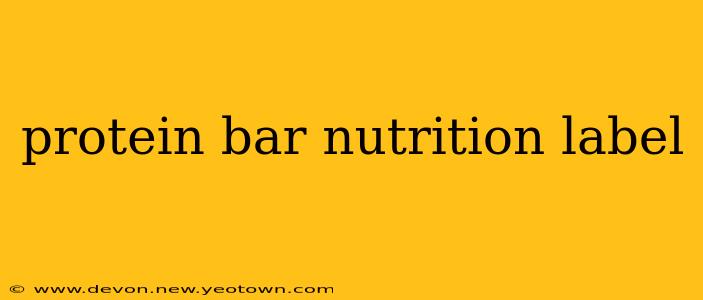Protein bars. They're everywhere – promising muscle growth, sustained energy, and convenient nutrition. But navigating the often-confusing nutrition label can feel like scaling a protein-packed Everest. This guide will help you decipher the label and make informed choices, turning you from a protein bar novice into a label-reading legend.
Let's start our journey with a story. Imagine Sarah, a busy professional trying to squeeze fitness into her hectic schedule. She grabs a protein bar, thinking it's a healthy, convenient snack. However, a closer look at the nutrition label reveals a shocking amount of added sugar and unhealthy fats. Sarah's experience highlights the crucial need to understand what's actually in that seemingly innocent bar.
What to Look For (and What to Avoid) on a Protein Bar Nutrition Label
The key to unlocking the secrets of a protein bar label lies in understanding the crucial components. Let's break down the essential elements:
1. Serving Size:
This is the foundation. Everything else on the label is based on this single serving. Pay close attention – many bars are divided into two or more servings. If you eat the whole bar, you're consuming multiple servings' worth of everything listed.
2. Calories:
Calories represent the energy provided by the bar. Consider your daily caloric needs and how this bar fits into your overall intake. High-calorie bars can contribute to weight gain if consumed excessively.
3. Total Fat, Saturated Fat, and Trans Fat:
Fat is essential, but the type of fat matters. Aim for bars with lower amounts of saturated and trans fats, both linked to heart disease. Unsaturated fats (like monounsaturated and polyunsaturated fats) are beneficial. The label should specify the type of fat.
4. Cholesterol:
Cholesterol is generally found in animal products. While not a major concern for most people, individuals with high cholesterol should pay close attention to this number.
5. Sodium:
Excessive sodium intake can contribute to high blood pressure. Check for bars with lower sodium content, especially if you're watching your salt intake.
6. Total Carbohydrate, Dietary Fiber, and Sugars:
Carbohydrates provide energy. Dietary fiber is crucial for digestive health. Pay attention to the "Sugars" line. Many protein bars are loaded with added sugars, which can negatively impact health. Opt for bars with lower added sugar content and higher fiber content.
7. Protein:
This is the star of the show! Check the amount of protein per serving. Remember, the protein content should be significant enough to justify the bar's claim.
8. Vitamins and Minerals:
Some bars are fortified with vitamins and minerals, offering added nutritional benefits. However, don't rely solely on a protein bar for your daily micronutrient needs.
How Much Protein is Actually in a Protein Bar?
This is a frequent question. Protein bars market themselves with high protein content, but the actual amount can vary widely. Always check the label for the grams of protein per serving, not just the percentage. A bar claiming 20g of protein is significantly different from one with 10g. Look for bars with at least 15-20 grams of protein per serving for a substantial boost.
Are Protein Bars Healthy? Do they help with Weight Loss?
Protein bars can be part of a healthy diet, but they are not a magical weight-loss solution. Their effectiveness depends heavily on the overall nutritional profile. Bars high in added sugar and unhealthy fats can hinder weight loss efforts. Choose bars with low sugar, moderate fat, and high protein content to maximize their benefits for weight management.
What are the Best Protein Bars?
There's no single "best" protein bar. The ideal bar depends on individual needs and preferences. Read labels carefully, comparing protein, fiber, sugar, and fat content. Experiment with different brands to find one that suits your taste and dietary goals.
By carefully reading the protein bar nutrition label and understanding the key components, Sarah—and you—can make more informed choices, ensuring your protein bar is a true nutritional ally, not a sneaky sugar bomb. Happy snacking!

